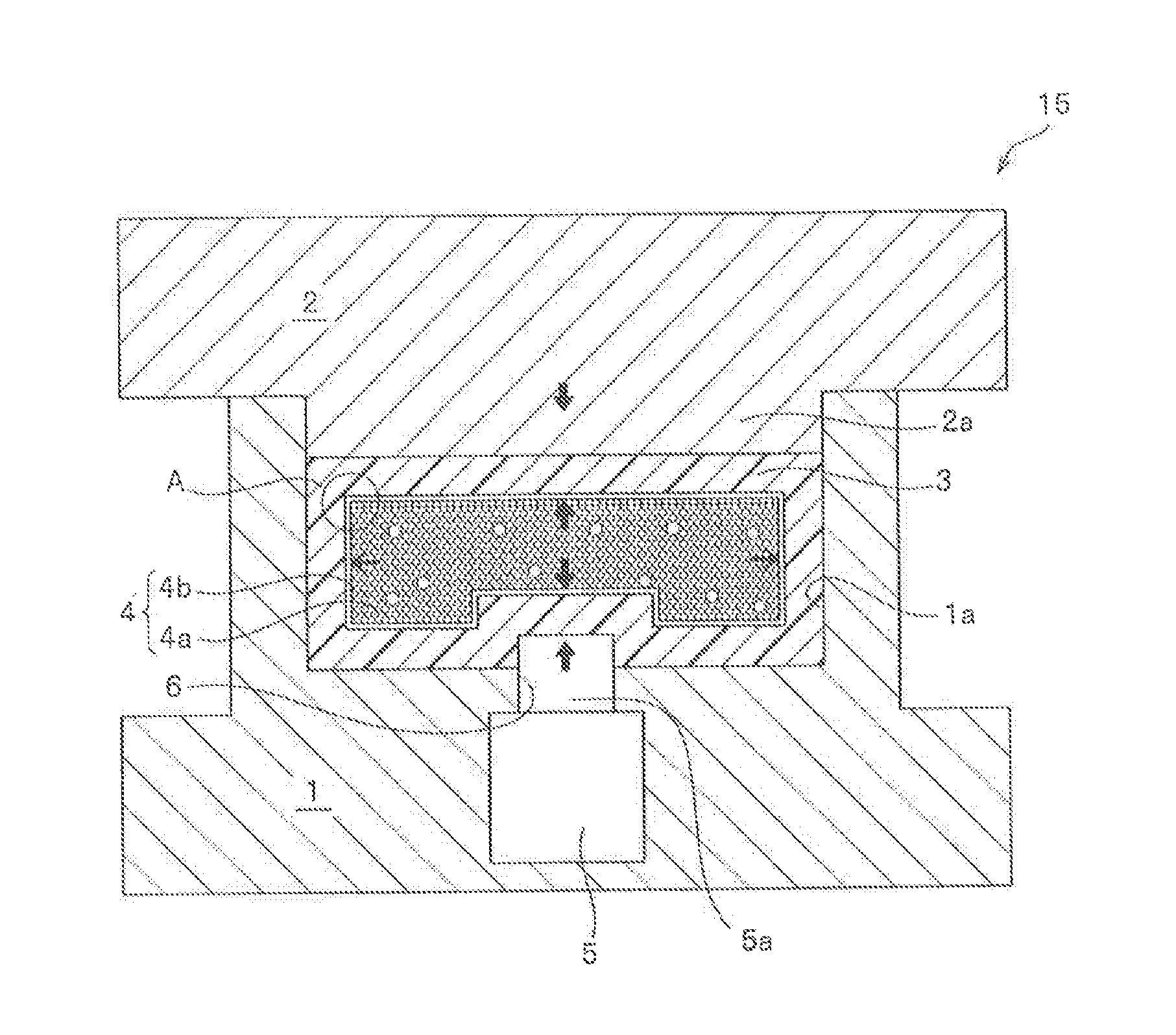Method for molding fiber-reinforced plastic, and molding device for same
a molding device and fiber-reinforced plastic technology, applied in the direction of butter manufacturing, transportation and packaging, other domestic articles, etc., can solve the problems of deformation of the core 43/b>, reduce the manufacturing cost of the mold required for molding, and increase the internal pressure of the deformation mold , the effect of reducing the cost of the molded articl
- Summary
- Abstract
- Description
- Claims
- Application Information
AI Technical Summary
Benefits of technology
Problems solved by technology
Method used
Image
Examples
example 1
[0118]As illustrated in FIG. 1, a core was manufactured by accommodating a grain group which contained a mixture of zirconia grains (grains (a) having a diameter of 3 mm and grains (b) having a diameter of 2 mm) having the ratio of grain diameters equal to 1.5 and including 20 mass % of grains (b) as the ratio of the total amount of the grains (b) included in the mixture of zirconia grains (the mixing ratio of the grains (b)), in a bag made of a nylon film. The core was wrapped in five plies of prepreg 3 of a carbon fiber-reinforced epoxy resin (product name: TR3110 391IMU, made by Mitsubishi Rayon Co., Ltd.) to make a preform having substantially the same shape as the inner circumferential surface shape of the molding die 15 at room temperature. The preform was placed in the concave portion 1a formed in the molding surface of the lower mold 1 of the molding die 15 heated to 140° C. in advance, and the upper mold 2 and the lower mold 1 were completely closed. Subsequently, a portion...
examples 2 to 4
[0119]Hollow molded articles (FIG. 3(c)) were obtained in the same manner as Example 1 except that the mixing ratios of the zirconia grains (b) included in the grain group 4a of the core 4 were as shown in Table 1.
modification example 1
[0125]While the upper mold 2 and the lower mold 1 are in a state of being closed to each other, or while the prepreg 3 is in a pressurized state of being pressurized by the upper mold 2 and the lower mold 1 at a predetermined pressure, the interval between the upper mold 2 and the lower mold 1 should not increase any more. Therefore, according to the illustrated examples, mold interval holding means 20 for maintaining the interval between the upper and lower molds 2 and 1 in a constant level are provided in the upper mold 2. As illustrated in FIG. 4, as the mold interval holding means 20, a configuration is employed in which the upper mold 2 is not raised by an increase in the pressing force to the upper mold 2 due to the deformation of the prepreg 3 even when the core 4 is pressed and deformed by the piston rod 5a.
[0126]In the example illustrated in FIGS. 4 and 7(A), the mold interval holding means 20 include wedge surfaces 21b and 21b which comes in sliding contact with downward ...
PUM
| Property | Measurement | Unit |
|---|---|---|
| flexural modulus | aaaaa | aaaaa |
| flexural modulus | aaaaa | aaaaa |
| thickness | aaaaa | aaaaa |
Abstract
Description
Claims
Application Information
 Login to View More
Login to View More - R&D
- Intellectual Property
- Life Sciences
- Materials
- Tech Scout
- Unparalleled Data Quality
- Higher Quality Content
- 60% Fewer Hallucinations
Browse by: Latest US Patents, China's latest patents, Technical Efficacy Thesaurus, Application Domain, Technology Topic, Popular Technical Reports.
© 2025 PatSnap. All rights reserved.Legal|Privacy policy|Modern Slavery Act Transparency Statement|Sitemap|About US| Contact US: help@patsnap.com



